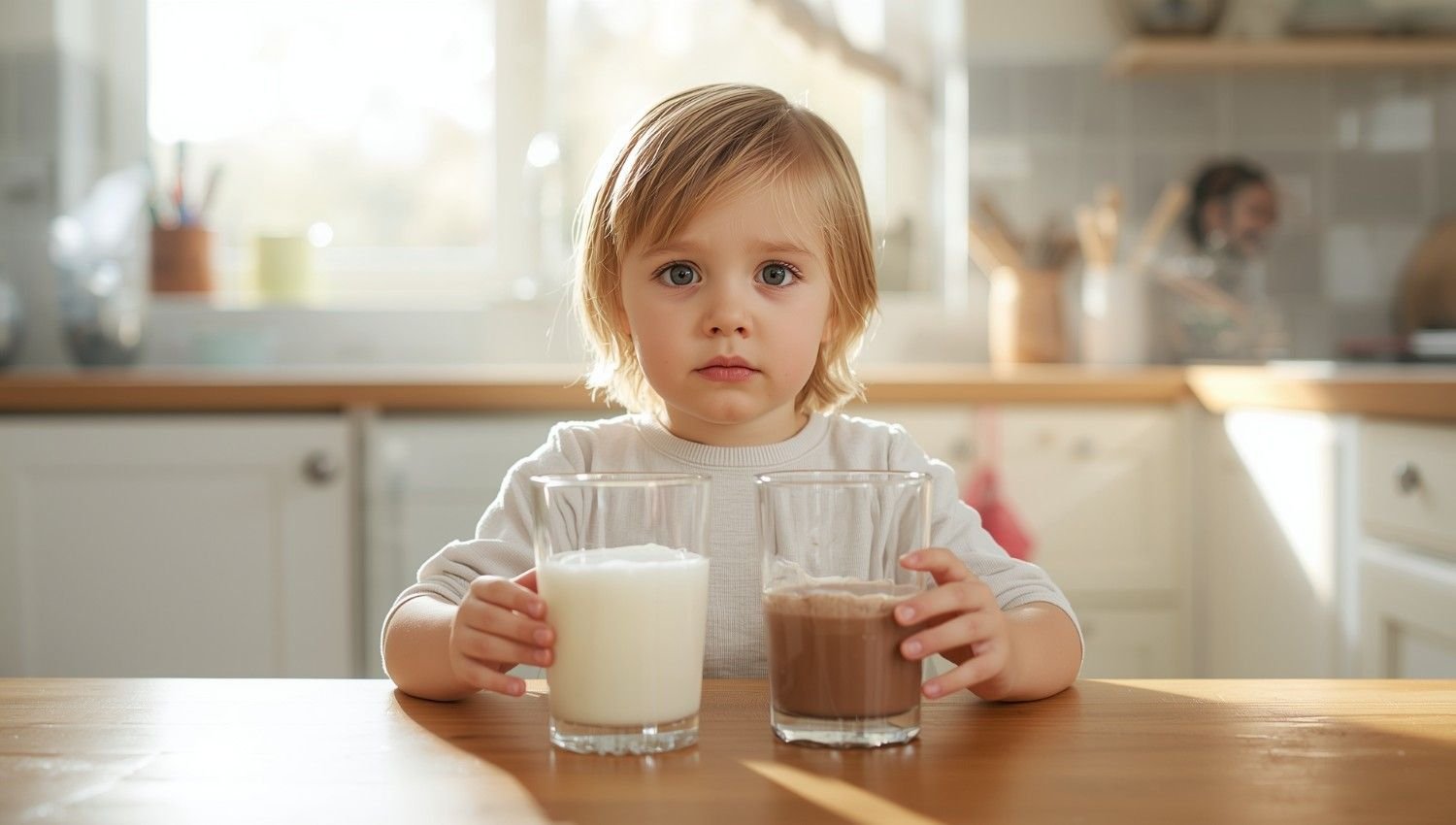Why Parents Ask: Is It Healthy for Kids to Drink Chocolate Milk?
Every parent wants to give their child something nutritious, tasty, and comforting — and chocolate milk often feels like the perfect middle ground. It’s creamy, flavorful, and packed with the same nutrients as regular milk. But when you look at the label and see the added sugar, it’s natural to wonder: Is this really a healthy choice? Should kids drink chocolate milk every day, or is it better as an occasional treat?
This question has been debated by parents, schools, and nutritionists for years. While some believe that chocolate milk is a great way to encourage milk consumption, others worry about its sugar content and long-term effects on childhood health. In this article, we’ll take a deep dive into everything you need to know about chocolate milk — from its nutritional value and health benefits to the risks of overconsumption and smart serving tips.
Let’s explore whether kids should drink chocolate milk, what experts recommend, and how you can make informed choices that support your child’s health and development.
The Nutritional Profile of Chocolate Milk
At its core, chocolate milk is simply milk — usually cow’s milk — flavored with cocoa and sugar (or sweeteners). This means it contains all the nutritional goodness of milk while adding a little sweetness and flavor.
Here’s what an 8-ounce (240 ml) glass of low-fat chocolate milk typically contains:
- Calories: 150–190 cal
- Protein: 8 g
- Carbohydrates: 26 g (12 g natural lactose + 12–14 g added sugar)
- Fat: 2.5–5 g
- Calcium: 300 mg (25–30 % DV)
- Vitamin D: 100 IU (15–20 % DV)
- Potassium: 400 mg
- Phosphorus, Riboflavin, Vitamin A, and B12 are also present in significant amounts.
So nutritionally, chocolate milk provides the same 13 essential nutrients found in regular milk. The main difference is the added sugar and, sometimes, flavoring additives that can slightly raise calorie content.
Key Benefits of Chocolate Milk for Kids
1. A Great Source of Calcium and Vitamin D
Calcium and vitamin D are crucial for building strong bones and teeth. Many children do not consume enough of these nutrients, which can lead to bone weakness later in life. Chocolate milk makes it easier for children — especially picky eaters — to meet their daily calcium goals.
2. Encourages Milk Consumption Among Picky Eaters
Not every child enjoys the taste of plain milk. Studies show that when milk is flavored, children are more likely to drink it regularly, ensuring they still get the essential nutrients. In fact, removing flavored milk from schools has been linked to a drop in total milk consumption among students.
3. Provides High-Quality Protein for Growth
Each glass of chocolate milk contains about 8 grams of complete protein, which helps in the development of muscles, tissues, and the immune system. Protein also keeps children feeling full longer, reducing the urge to snack on less-nutritious foods.
4. Supports Energy and Recovery After Physical Activity
For active kids, the combination of protein and carbohydrates in chocolate milk helps replenish glycogen stores and repair muscle tissue. Many pediatric sports nutritionists recommend it as an occasional post-activity recovery drink, similar to how athletes use it after workouts.
5. Rich in Micronutrients for Overall Health
Chocolate milk offers more than just calcium — it’s also rich in potassium, magnesium, vitamin B12, and phosphorus, all essential for nerve function, heart health, and energy metabolism.

The Downside: Sugar and Calories
Of course, every sweet advantage comes with a trade-off. The major concern with chocolate milk is its added sugar content.
1. How Much Sugar Does It Contain?
On average, one serving of chocolate milk contains 10–14 grams of added sugar (roughly 2–3 teaspoons). While that may not seem like much, it adds up quickly — especially if a child drinks it daily.
The American Heart Association recommends limiting added sugar intake to:
- 25 g (6 tsp) per day for children aged 2–18
So, just one glass of chocolate milk can contribute almost half of a child’s daily sugar limit.
2. Potential Impact on Weight and Metabolism
Although studies haven’t found a direct link between flavored milk and obesity, excess calorie intake can lead to gradual weight gain if not balanced with activity and diet. Over time, too much added sugar can also raise the risk of type 2 diabetes and metabolic syndrome.
3. Dental Health Concerns
Sugar feeds oral bacteria, leading to cavities. If your child drinks chocolate milk often, it’s best to serve it with meals and encourage brushing afterward.
What Do Experts Say?
The American Academy of Pediatrics (AAP) acknowledges that flavored milk can be part of a healthy diet if consumed in moderation. The Academy of Nutrition and Dietetics also supports its inclusion, stating that the nutrients in milk outweigh the drawbacks of the added sugar — provided it doesn’t replace water or plain milk entirely.
Many schools have reintroduced flavored milk after realizing that banning it led to a dramatic drop in calcium and vitamin D intake among students. The consensus: flavored milk is acceptable occasionally, especially for children who might otherwise skip milk altogether.

Comparing Whole, 2 %, and Low-Fat Chocolate Milk
When choosing chocolate milk, fat content matters too. Here’s how the options compare:
| Type | Calories | Fat | Best For |
|---|---|---|---|
| Whole chocolate milk | ~190 cal | 8 g | Toddlers under age 2 who need dietary fat |
| 2 % (reduced-fat) | ~160 cal | 5 g | School-aged kids with normal growth patterns |
| 1 % (low-fat) | ~140 cal | 2.5 g | Older children or those watching calorie intake |
| Skim (fat-free) | ~130 cal | 0 g | Kids who already get enough fat from food |
Tip: Choose low-fat or skim versions for kids over 2 years old. They still deliver the same nutrients, just with fewer calories and saturated fats.
When Kids Should Drink Chocolate Milk
- After Physical Activity
Post-play or after-school sports sessions are perfect times to serve chocolate milk. The carb-protein combination aids muscle recovery and replenishes energy. - With Meals, Not Alone
Pairing chocolate milk with balanced meals (like breakfast or lunch) helps slow sugar absorption and supports better digestion. - Occasionally, Not Daily
Chocolate milk shouldn’t be a daily habit. Think of it as a nutrient-rich treat—a healthier alternative to soda or juice but not a substitute for water or plain milk.
When to Avoid or Limit Chocolate Milk
While it’s safe for most kids, some situations call for moderation or avoidance:
- Under age 2: Babies and toddlers should drink breast milk or whole milk only — no flavored milk.
- Overweight or obese children: Choose plain low-fat milk instead to reduce calories.
- Lactose intolerance: Opt for lactose-free chocolate milk or plant-based alternatives fortified with calcium and vitamin D.
- Allergies: For dairy-allergic kids, choose soy or oat-based chocolate milk — but check sugar content.

How to Make Chocolate Milk Healthier at Home
Homemade chocolate milk can be just as delicious — and far healthier. Here’s how:
1. DIY Cocoa Blend
Mix unsweetened cocoa powder, a small drizzle of honey or maple syrup, and a pinch of vanilla extract with warm milk. Stir until smooth, then chill. You control the sweetness and avoid artificial flavorings.
2. Use Dark Cocoa
Dark cocoa contains antioxidants (flavonoids), which support heart health and immunity.
3. Add Nutrient Boosters
Blend in banana, peanut butter, or a spoonful of Greek yogurt for extra protein and potassium.
4. Gradual Flavor Training
Start by mixing ¾ chocolate milk with ¼ plain milk. Over time, increase the plain milk ratio. Many kids adjust naturally to less sweetness.
Plant-Based Chocolate Milk Alternatives
If your child can’t drink cow’s milk, there are many fortified, plant-based options:
| Type | Nutritional Highlights | Watch For |
|---|---|---|
| Soy milk | Closest to dairy milk in protein and calcium | Added sugar, flavor additives |
| Almond milk | Low calorie, vitamin E rich | Very low protein |
| Oat milk | Creamy texture, good carbs | Often higher in sugar |
| Pea protein milk | High protein, allergy-friendly | Expensive and less available |
Choose fortified plant milks with added calcium, vitamin D, and B12. Always read labels — some flavored varieties have more sugar than cow’s chocolate milk.
The Role of Chocolate Milk in Schools
School milk programs often use chocolate milk to encourage children to consume dairy. The controversy lies between nutritional necessity and added sugar.
- Supporters argue that chocolate milk increases calcium intake and reduces soft-drink consumption.
- Critics worry about long-term sugar exposure and taste preferences leaning toward sweetness.
Recent school nutrition policies emphasize offering both plain and flavored options, but in smaller portion sizes (6–8 oz). That balance encourages choice without excess sugar.
The Science Behind Milk and Child Development
Milk, in any form, supports growth, cognitive function, and bone strength. Protein and calcium play critical roles in muscle and brain tissue formation. Vitamin D aids immune function and helps the body absorb calcium effectively.
Children who consume adequate dairy have been shown to have:
- Stronger bone density in adolescence
- Better school performance linked to stable energy
- Lower risk of nutrient deficiencies like vitamin D and B12
Thus, even flavored milk can contribute positively — provided sugar intake is managed responsibly.

Common Myths About Chocolate Milk
Myth 1: Chocolate milk causes obesity.
→ There’s no evidence that moderate chocolate milk intake causes weight gain when part of a balanced diet.
Myth 2: It’s just a dessert in disguise.
→ Unlike soda or candy, chocolate milk still provides essential nutrients, making it a more nutritious alternative.
Myth 3: Removing chocolate milk helps kids eat healthier.
→ Studies show that banning flavored milk often reduces overall dairy consumption, leading to nutrient gaps.
Myth 4: Chocolate milk and caffeine aren’t safe for kids.
→ The caffeine in cocoa is minimal — around 2 mg per cup, far less than a serving of chocolate ice cream or hot cocoa.
How Much Chocolate Milk Is Okay?
Moderation is the rule. For most children over 2:
- Serving size: ½ to 1 cup (4–8 oz)
- Frequency: A few times per week
- Timing: With meals or after physical activity
Keep in mind that the goal isn’t to ban chocolate milk but to balance it within the diet.
Professional Insight: What Pediatricians Suggest
Pediatric nutritionists emphasize the concept of “total diet quality.” Occasional chocolate milk is fine if:
- The child eats balanced meals with fruits, veggies, and whole grains.
- Water remains their main drink.
- Sugary drinks like soda or fruit punch are limited.
In fact, some experts prefer chocolate milk over juice boxes because it provides protein and nutrients that fruit juice lacks.
Healthy Milk Habits for Parents to Encourage
- Model good behavior — children mimic parents’ habits. If they see you enjoy balanced meals and plain milk, they’re more likely to do the same.
- Keep chocolate milk occasional — treat it like dessert rather than an everyday drink.
- Avoid bedtime milk with sugar — serve earlier to prevent dental issues.
- Offer variety — mix dairy and non-dairy sources (yogurt, cheese, soy milk).
- Consult professionals — a pediatrician or dietitian can guide portion sizes based on your child’s growth pattern.
Conclusion
So, should kids drink chocolate milk? The answer lies in moderation and context. Chocolate milk can absolutely fit into a healthy child’s diet — it’s nutrient-dense, enjoyable, and far better than sugary sodas or juices. However, it shouldn’t replace plain milk or water as a primary beverage.
When used wisely — especially with low-fat milk, limited portions, and balanced meals — chocolate milk can be both a wholesome treat and a valuable source of nutrients. For growing kids who need calcium, vitamin D, and protein, it can even be a helpful tool.
As parents, our goal isn’t perfection but balance — giving children foods they love while nurturing lifelong healthy habits.
FAQs
1. How often can kids drink chocolate milk?
Children can enjoy chocolate milk a few times per week in moderation — ideally one 4- to 8-ounce serving, paired with meals.
2. Does chocolate milk have caffeine?
Yes, but very little — around 2–5 mg per serving, which is harmless for kids.
3. Can toddlers under 2 have chocolate milk?
No. Babies and toddlers should drink breast milk or whole milk only. Avoid flavored or sweetened beverages before age 2.
4. Which is better — store-bought or homemade chocolate milk?
Homemade versions let you control sweetness and use natural ingredients like cocoa powder and honey, making them healthier.
5. Is chocolate milk better than juice or soda?
Yes. Chocolate milk offers protein, calcium, and vitamin D, while juice and soda provide mainly sugar with no protein or fat balance.
6. Can lactose-intolerant kids drink chocolate milk?
Yes, if you choose lactose-free or plant-based fortified versions such as soy or oat chocolate milk.
7. What time of day is best for kids to drink chocolate milk?
Serve it after school or post-activity, not before bedtime. The protein helps recovery, and avoiding it at night protects dental health.
8. Can chocolate milk improve athletic performance in children?
For active kids, yes — the mix of protein and carbs helps muscle recovery after sports, similar to a post-workout drink.
9. What’s a healthy alternative if I don’t want to give store-bought chocolate milk?
Blend warm milk, unsweetened cocoa, and a touch of honey or date syrup for a low-sugar, homemade option.
10. What’s the best portion size for kids?
4–8 oz (½–1 cup) is sufficient. Anything more could add unnecessary sugar and calories.

